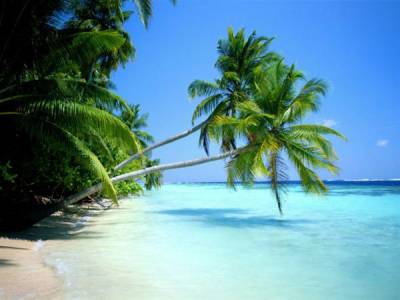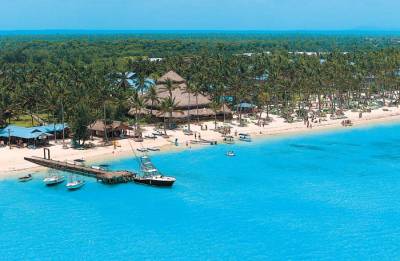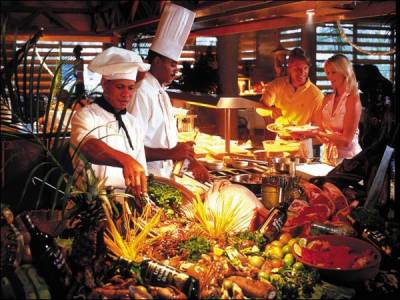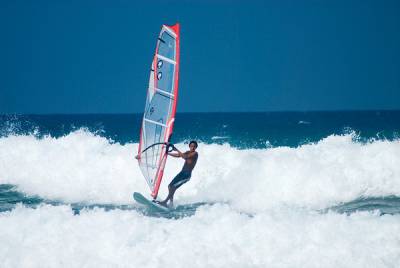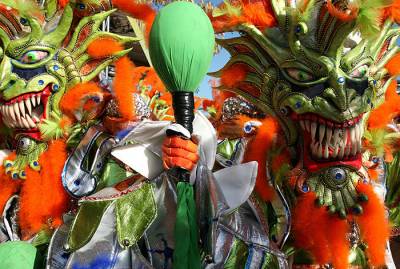DOMINICAN REPUBLIC
GEOGRAPHY AND GENERAL INFORMATION
Dominican Republic (Spanish: República Dominicana) - the country occupying the eastern part of the island of Haiti in the Caribbean Sea and the adjacent islands. The western part of the island is occupied by the State of Haiti Republic of Haiti. The entire island of Haiti is part of the Greater Antilles archipelago. The capital of the Dominican Republic - the city of Santo Domingo. The population is about 9.65 million people (as of 2009).
In addition to the main area on the island of Haiti (Hispaniola), the Dominican Republic belongs to many smaller islands, of which the largest are Saona and Beata.
The main directions of export are such foods as sugar, coffee, cocoa and tobacco. In addition, the export also sent gold, silver, ferronickel, iron and nickel ore. The country occupies a strategic position at the crossroads of trade routes from Europe and the United States to the Panama Canal.
Fauna of the country is very diverse: parrots, green iguanas, American crocodiles living in a special reserve, a great variety of birds and bats. No snakes. Marine Life shows dolphins, manatees, humpback whales, turtles, large tropical fish, crabs, lobsters, crayfish. Sharks just off the coast there.
LANGUAGE
The official language is Spanish.
CLIMATE
The Dominican Republic is located in the area of the Caribbean, so the year-round great weather. Summer temperatures can range from 32 C to 23 C during the day in the morning. In winter the average temperature is 19 C. In the mountains cities Jarabacoa and Constanza is and colder, and the temperature can drop to 5 ° C. In relation to climate change is difficult to accurately determine the rainy season. Rain can be at any time of year, but it usually is not long - day or night. The warmest months of the year - June, July, August and September.
CUSTOMS
Citizens and residents of the United States, Canada and most European countries can enter the country with a 30-day tourist card, which can be purchased at admission for $ 10. Any person, regardless of nationality, have the right to enter the territory of the Dominican Republic with a tourist card, if the person in the passport contains the following valid visas: visas the United States, the United Kingdom or the European Union (Schengen visa). If you wish to extend your tourist card, you will need to pay $ 20 (RD $ 800) immigration service when you leave the country. Tax on leaving the country is U.S. $ 20, and are usually included in the ticket price.
KITCHEN
The Dominican Republic a great reputation due to a variety of restaurants and lots of taste. Here you will find refined luxury restaurants offering gourmet menu, and a variety of restaurants with traditional Creole cuisine, decorated in traditional style. Here you will also find restaurants with Eastern, Mexican, Mediterranean and Italian cuisine, as well as restaurants with mild or vegetarian food, pizzerias and fast-service "fast food."
If you like a drink or after dinner entertainment, bars and cafes in most towns are open until 02:00 on Fridays, Saturdays and holidays.
TRANSPORT
Across the country ply comfortable buses. Taxis are also readily available, they can "catch" at any point in the city. Value of certain pre-established routes. Car hire expensive, foreign driver's licenses are valid 90 days.
SAFETY
Despite the fact that the Dominican Republic is one of the safest countries on the continent, you should still use caution when traveling in any of the cities:
- Always use the hotel safe to store your passport, money and other valuables
- Keep a copy of your passport when you travel to different cities
- Bring only what you need. If possible, bring your credit card and cash.
- Do not leave valuables or bags in a prominent place in vehicles
- Refrain from traveling into the dark and remote places in the insecure time.
- If you plan to go to any entertainment venue at night, call a taxi from your hotelTipping:
SHOPS
Typically, speaking of shopping in the Dominican Republic, meaning shopping in Santo Domingo. Santo Domingo is the center of the Caribbean shopping at all - here are the largest commercial and shopping centers of the region.
All the tourists who want to go shopping in the capital of the Dominican Republic, is sent to the famous Malekon - Avenue, which runs for 15 kilometers along the coast. Here you can find not only a great variety of bars, restaurants, discos and theaters, but also a lot of shops. The best shopping areas of the capital market is considered Mercado Modelo Avenue Mella and colorful shopping street Konde.
SOUVENIRS
One of the most popular for Europeans - colorful paintings in the style of "Haitian naive." You can buy them at the beach and in the markets. Haggle, most likely you will be able to conspire for a third or half of the originally advertised price.
Tourist areas of the country to offer the tourists there are numerous boutiques and souvenir shops where you can purchase a variety of products of wood, bone, amber, Larimar, ceramics, coffee, rum, cigars, souvenirs Tainos Indians, Creole dolls. Specifically recommended tapes melodies "merengue" and salsa. In Santo Domingo is the largest commercial centers in kotoryhmozhno buy clothes, shoes, light industry products domestic and foreign firms of good quality and at affordable prices.
TIPPING
Invoices in restaurants already include 10 percent gratuity. Decided to give an additional 10 percent for good service. Most people do not tip taxi drivers, but if you want, you can give a tip
WHAT TO SEE
The oldest part of the center of Santo Domingo was built in the XVI century, it is dominated by the monuments of the colonial era.
Faro Colon - lighthouse built on the site of the old lighthouse, which was built here in Columbus. In the middle of the building is a sarcophagus, in which the remains of the great explorer Christopher Columbus, according to his will. The complex is guarded naval guard. In Faro Colon, a museum about the history of the Dominican Republic.
At night, the lighthouse beam emanates bright light directed at the sky, it is visible from almost anywhere in the city. Faro Colon complex is surrounded by a large park that has become a favorite destination of Dominicans and visitors. Information about the complex is available at the Ministry of Culture of the Dominican Republic.
Alcázar de Colón, or Palace of Columbus, located on the esplanade of the river Ozama. The building was erected in 1514 by the order of Diego Columbus - son of Christopher Columbus, from pieces of coral reef at its construction was the use of a single nail. The building has 22 rooms, where a unique collection of original items of the era: ancient manuscripts, portraits of the owners, furniture and interior design. Information about the museum - the site of the Ministry of Culture of the Dominican Republic.
Ozama Fortress - the first fortress in the New World, built between 1502-1507 years. In its courtyard stands the Torre del Omenahe - witness all the major stages of Dominican history. In its dungeons rebels held the Indians, and in the Republican period were sent here as prisoners. At all times, the Dominican conquerors tried immediately hoisted their national flag on the tower Torre del Omenahe. Visit the fortress is to inspect the tower, the ruins of the ramparts, the old arsenal and influential Dominican house Rodrigo de Bastidas, adjacent to the castle.
In addition to these attractions, tourists in the capital of the Dominican Republic can explore Fort Concepcion (XVII c.), Captain's Palace - Casa de Bastidas (XVI c.), Sundial (1753), located at the end of the street Kalle des las Damac, the first stone house on the island - Kasa-del-Kopdon so-called "House of the ribbon" (1503), the palaces of the Casa del Duarte and Casa Borgelya Street Isabel la Catolica, the first fortress of the New World - La Fortaleza (or "Fort of Worship") Mint - Casa de la Moneda (XVI c.) and the first hospital in the continent - St. Nicholas (1503-1505 gg.). Also worth visiting is the National Pantheon, the mausoleum Baluarte or "Altar of the Motherland", which contains the tombs of the founders of the Dominican Republic - Duarte, Sanchez and Mella.
The city has many churches, because of the historically: hence the Christian church had intended to bring the light of faith, the Aborigines. Symbol of Santo Domingo is the cathedral of Santa Maria la Menor, or Cathedral of Santo Domingo.
It is a temple built in honor of the Holy Virgin in the years 1514-1540. It is the oldest cathedral in the Americas. The building is constructed of limestone golden coral. Cathedral style combines Gothic and Baroque, with a strong influence Plateresque, most notably in the decoration of the altar. Among the treasures of the cathedral - a rich collection of statues carved from wood, furniture, jewelery and silver utensils. On the cathedral square stands a monument to Christopher Columbus. In 1990, as part of the architectural complex of the colonial city of Santo Domingo Cathedral was included in the UNESCO World Heritage List.
No less interesting is the Church of St. Nicholas (XVI c.), A church-Rekhin Anhelorum (XVI century). Outside Padre Bellini, Dominican Convent (Los Dominikos, 1510), the Monastery of Santa Clara (1522), the Chapel of St. Andrew, and the church and convent of Nuestra Señora de las Mercedes (1530), is now the Dominican Academy of History, etc.
In Santo Domingo, many museums. The most interesting are the Colonial Museum Las Casas Reales (1513-1520 gg.) On journeys of Columbus and the development of Spanish culture in the New World. Also worth visiting the Dominican Museum, located in the former home of Hernán Cortés, the House-museum of one of the founders of the Dominican Republic - Juan Pablo Duarte.
Natural Park of Los Tres Ojos, or "three eyes", is located near the capital of the Dominican Republic. In the park you can visit the zoo, the aquarium, caves with stalactites and stalagmites, cave in which the depth of 15 meters on three sulfide lake with dark blue water, which gave the name of the park. In addition, in Santo Domingo, a huge number of tropical parks, among which the most popular Duarte, Mirador del Sur Mirador del Este Park Columbus. Noteworthy is the National Botanic Garden with a rich collection of tropical plants.
Puerto Plata
The main attractions of the resort of Puerto Plata - Amber Museum, the Colonial Zone of the fortress of San Felipe (Fortaleza de San Felipe), built in 1540, Independence Park, famous for its Victorian buildings in the spirit of St. Philip's Cathedral (Catedral de San Felipe), Beacon Fortaleza, chocolate factory, plant Brugal rum.
South-west of Puerto Plata towering mountain Monte Isabel de Toros (2621 m), on top of which a viewing platform and offers a wonderful view of the surroundings. You can reach it by cable car. Also at the top you can see the huge bronze statue of Christ the Saviour - a copy of the famous Brazilian figures, only smaller, and stroll through the stretching out on the slopes of the botanical garden. By the way, on top of the mountain Monte Isabel de Toros filmed several episodes of the film "Jurassic Park."
Santiago
Santiago - home of music "mepenge." Among the attractions of the city - the Cathedral of Santiago (1868-1895 gg.) In the park Duarte Myzey Tomaca Mopeya National Museum of tobacco. Here, visitors have the opportunity to visit the famous tobacco factories Jean Clement, Leon Jimenes and the company "Tabakalera." In the suburbs of Santiago - city of Moca, which is considered the capital of the coffee production in the country, you can see some beautiful churches, and are familiar with the processing of coffee.
La Vega
West of Santiago lies the fertile valley of La Vega Real, it is the city of La Vega, who had once been the summer residence of the Spanish viceroy. Here you can see the national shrine - the Church of Our Lady of Las Mercedes (XIX century) at the foot of the Santo Cerro, inspect the area of archaeological excavations in the old city fire station building (XVII c.), And visit the traditional carnival "Vega" taking place February 27.
Wildlife enthusiasts and fans of ecotourism seek to enter the Pedernales Peninsula, known for three unique national parks. This National Park Yaragua - huge national park, which is home to 130 species of birds, the National Park of Sierra de Bahoruco - a mountainous region, famous for its orchids growing in, the island Isla Kabritos National Park, with a huge variety of fauna. In the bay there are excellent opportunities for diving, are found here in abundance groupers, baleen sharks and manatees.
Opportunities for ecotourism are being opened up on the peninsula Samana. Attention should be given National Park with caves Gaitises San Gabriel, Angel, Arena, and Linea, and Marine Reserve Banco de la Plata, which from mid-January to mid-March, you can watch the population of humpback whales.
In addition to the above, are interesting as national parks Del Este Los Aytises, and Armando Bermudez.
